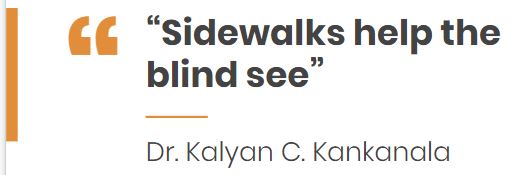Ever have that acute feeling of miasma that comes from having identified a problem but knowing that you’ll need to convince multiple people, over multiple years, to help you solve it? You aren’t alone, we all struggle to evolve our digital communications platforms, fix our internal business processes, and develop a shared approach between departments. Having been lucky enough to encounter this feeling multiple times over multiple years, with tens of organizations, I’m excited to tell you about an approach to solving this issue we call “Engagement Architecture Roadmaps.” (catchy right?) EARs map change management and technology investments to long-term business goals, typically over a three-year time period.
Clients tell us that these roadmaps are refreshingly holistic in their thinking, and help tie together politics, technology, and strategy into an easy to understand vision. Yet while the substance of these plans may be innovative, we can’t pretend the word “roadmap” is itself creative. Maps are invaluable for getting to an unfamiliar destination, helping everyone contribute to the plan, and for reducing anxiety that you won’t know where to stop for gas, food, or rest. At the same time, many businesses use the term “roadmap” and we’re keenly aware that it can be seen as American business jargon, rather than something practical and useful. (Similar to jargon-bingo favorites like “ideation,” “scalability” and “value-add”)
A roadmap by any other name would smell as sweet
How is our roadmap different from other kinds of planning documents your organization uses? While plenty of agencies will help refresh your website, deploy a CRM, or even create a marketing plan that can span across your digital channels, that work is almost always in the service of an acute departmental need, and rarely in the service of an organization wide program. This is despite the fact that most of these big systems provide services and functionality to many parts of your organization. Instead of focusing on these piecemeal projects, the heart of our work focuses on helping smart organizations optimize and integrate change efforts across all systems that drive engagement.
Our roadmaps are cross departmental, and build consensus and buy in between departments and between executives and departments.
As you’d expect, the depth and breadth of a roadmap varies based on a client’s level of ambition (and their budget). However, almost all of our roadmaps include these elements:
- An enterprise-wide vision for how outreach systems and technology can best be organized and configured to improve business performance
- A comprehensive audit of all existing outreach systems and processes (e.g. email, website, event management, CRM, etc.)
- An in-depth assessment what’s working well, and what’s not, informed by leadership interviews and facilitated discussions with departmental stakeholders
- A prioritized list of projects that will improve the efficiency and effectiveness of outreach (including estimated time, money and resources required for each incremental improvement)
- Platform management guidance around:
- Lifecycle planning for all relevant systems and services
- Budgeting
- Change management, training, and adoption
 Engagement Architecture Roadmaps help turn abstract and hard to visualize needs into clear, useful maps for creating change. Some of the unique features in our roadmaps are:
Engagement Architecture Roadmaps help turn abstract and hard to visualize needs into clear, useful maps for creating change. Some of the unique features in our roadmaps are:
-
A tight focus on improving your communications and outreach capabilities complemented with deep technical expertise.
Our roadmaps aren’t the same things you’ll get from McKinsey, they focus on achieving your organizational goals, not changing your organizational mission or brand positioning. Our work is deeply strategic in nature and it complements and connects to your organization’s existing strategic plan. This roadmap is focused on practical, evolutionary improvement, not reimagining your business.
-
A blend of technical improvements, strategic planning, and most importantly change management.
Many people become familiar with roadmaps in the context of “product” or “program” roadmaps, and these typically give a high-level visual representation of a single workstreams goals and deliverables. In contrast, our roadmaps are focused on the strategic positioning of resources and systems at the leadership level. They take a portfolio approach to systems and processes, identifying how you should be invested, and for how long, in different components. Our roadmaps include in-depth recommendations for change management, budgeting, and staffing each roadmap element that typical project-based roadmaps rarely (if ever) include.
-
A process designed to break down silos across departments and functions.
Our proprietary approach to developing and drafting the roadmap builds support and consensus for your goals and strategy across the organization while preparing the ground for change. While we deliver the Roadmap at the end of the process, it is actually the process of designing and drafting the roadmap collaboratively that begins internal movement towards positive change.
-
A map with a clear destination, yet one that provides flexible route planning on how to get there.
It’s impossible to know when new outreach channels will explode in popularity, new tools will become cheap enough to acquire, or new organizational hot button issues will need to be addressed. A useful roadmap has to be able to adapt and evolve, and not get in the way of you pouncing on new opportunities or responding to urgent concerns. We’ve developed a process that allows roadmap elements to be re-ordered, re-organized, and iteratively improved without having to rebuild the entire roadmap from scratch. Our roadmaps can be useful for three years precisely because they are living documents that provide high fidelity planning in the short term, while allowing for flexibility in how long term goals are pursued.
-
We help you evolve your organization not just by adding new components, but also by helping you sunset systems that are no longer serving you well
Far too many organizations find their ability to pivot quickly, invest in creative ideas, and experiment hamstrung by the sheer amount of day to day work they have on their plates. Often this is due to a critical lack of lifecycle planning focused on the smart retirement of systems or strategies. A major benefit of roadmapping is that it allows you to gracefully retire elements of your outreach that are not generating value, allowing you to focus capacity on innovation and generating real value.
What do you think?
We’d love your feedback: Is the term “roadmap” the best way to capture what we do, or do you have other ideas on what we should call our most useful deliverable for sustaining change?






